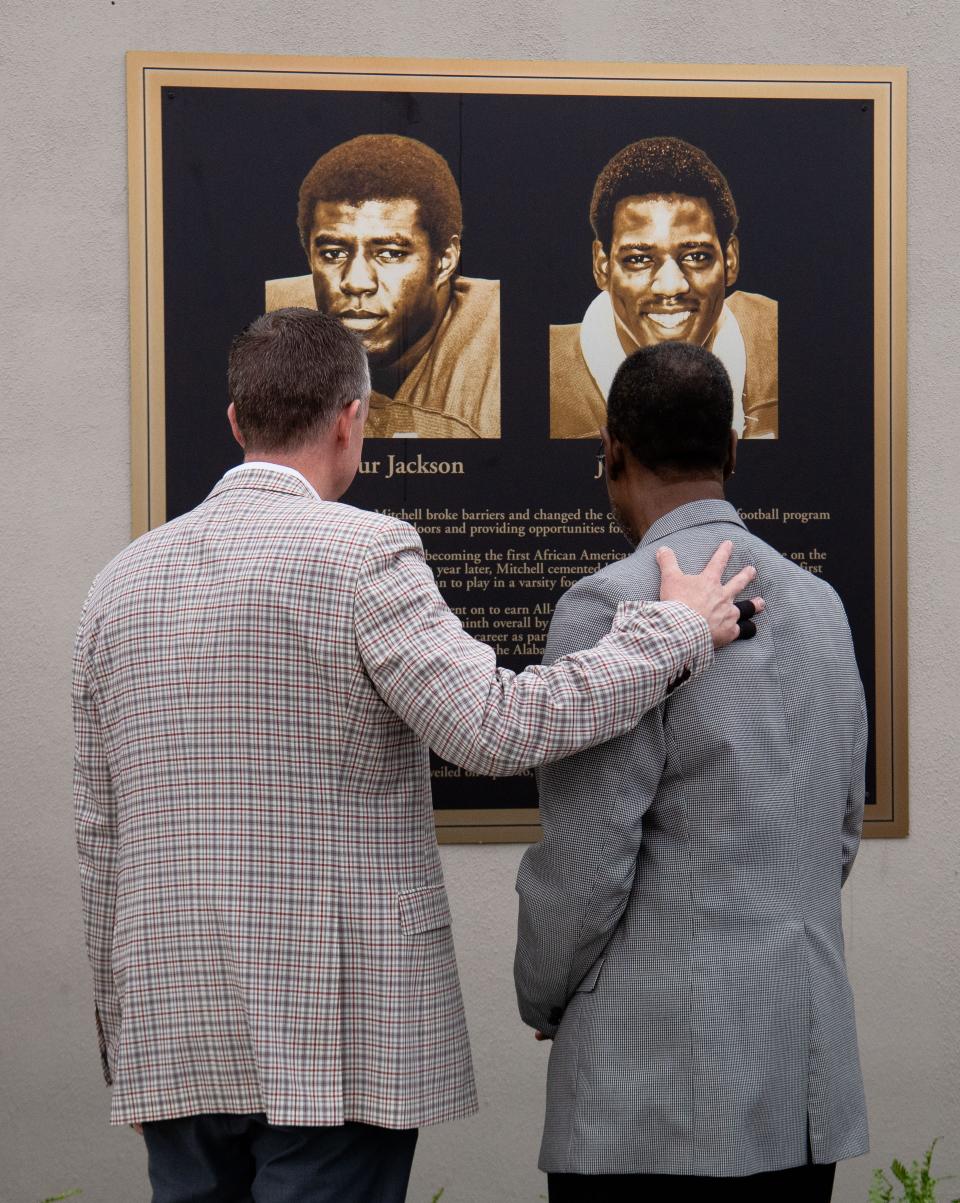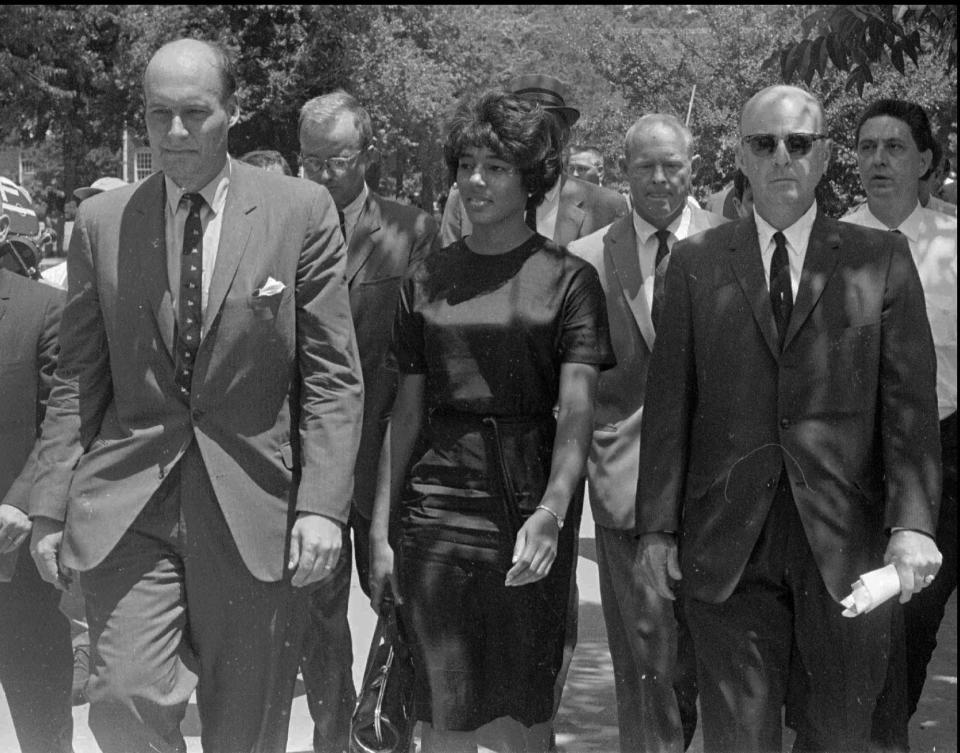MY TURN | GEORGE DANIELS: Six reasons to celebrate, 60 years after Wallace's 'Stand'
- Oops!Something went wrong.Please try again later.
- Oops!Something went wrong.Please try again later.
- Oops!Something went wrong.Please try again later.
- Oops!Something went wrong.Please try again later.
As the University of Alabama prepares to mark 60 years since the first African-American students were successfully enrolled, there are far more reasons to celebrate than to complain as we seek to achieve racial equality here on the Tuscaloosa campus.
Vivian Malone and James Hood registered for classes on June 11, 1963, after Gov. George Wallace made his famous "Stand in the Schoolhouse Door" at Foster Auditorium. Wallace’s stand put Alabama in the national headlines that day.
This year’s 60th anniversary probably won’t gain such national attention. As one preparing the next generation of journalists, I certainly understand why progress in diversity isn’t always big news.
But, like any good story, there are some nuances in the data. And, there’s more to tell than just the numbers.
Since I’ve been through at least two of these "Schoolhouse Door" anniversary celebrations, the 40th anniversary in 2003 and the 50th anniversary in 2013, I feel both qualified and compelled to tell this story.
This comes from one who has had the privilege of teaching undergraduate and graduate students for 20 years in UA’s College of Communication and Information Sciences, including six years as the college’s diversity officer.
I think there are at least six reasons to celebrate progress in opening doors and minds of students of all races. But, there are also three reasons to complain about barriers that remain when it comes to diversity, equity and inclusion.
Reason to Celebrate No. 1: Near record-tying Black student undergraduate enrollment.
Vivian Malone and James Hood were seeking to enroll as undergraduate students in 1963. According to the latest data from the UA Factbook, in fall 2022, we have 3,352 full-time African-American undergraduate students. That’s just five students short of the record high of 3,357 in 2015. This figure does not include students who identify as two or more races.
![Lacy Gather, right, prays for Melvon Brumfield after a protest gathering in front of Fosters Auditorium on the campus of the University of Alabama Saturday, June 6, 2020, to make their voices heard in the outcry against racial injustice. Fosters Auditorium is the site of then Governor George Wallace's infamous stand in the schoolhouse door in an attempt to block the integration of the University in June of 1963. [Staff Photo/Gary Cosby Jr.]](https://s.yimg.com/ny/api/res/1.2/uMwWtR7xo2jbPST9GONiWw--/YXBwaWQ9aGlnaGxhbmRlcjt3PTk2MDtoPTY2Nw--/https://media.zenfs.com/en/the-tuscaloosa-news/efc5fbd5a526208507c937b652568250)
Nowadays many of those African-American female students are welcomed to campus in programs such as Lucy’s Legacy, named after Autherine Lucy, who made an unsuccessful attempt to integrate the university in 1956. I’ve been pleased to be involved in our Bridge Program for African-American males in their first year on campus. Lucy’s Legacy and Bridge are two of our First-Year Experience (FYE) initiatives. And, this year, I’ve witnessed several of those students take leadership roles in my classes and in student organizations on campus. Last month, we had some of our first graduates from Bridge receive their degrees. I think both the late James Hood and the late Mrs. Vivian Malone Jones would be happy to see this progress.
Reason to Celebrate No. 2: Black graduates who are making worldwide impact with their work.
After African-American students leave our campus, they are making national impact while engaging their communities. Kendra Key, a 2010 graduate recently joined Regions Bank as a senior vice president in the Community Affairs division working in the Birmingham area. I couldn’t be prouder of one of my former journalism students, Victor Luckerson, who’s making the rounds on the national talk shows promoting his new book on Tulsa’s Black Wall Street. I predict "Built from Fire," released just last month, will be a New York Times best-seller. Some of those Black graduates have worked in the industry and made their way back here to the Capstone. Such is the case with Deidre Diaz, UA’s director of corporate and foundation relations in UA’s Office of Development.
Reason to Celebrate No. 3: More Recognition of African-American trailblazers on UA campus.
Thanks to the foresight (and perhaps a little pressure from students on campus), we have three buildings named for African-American trailblazers. John England Hall, a freshman residential community that honors one of the first African-American Tuscaloosa City Council members, retired circuit court judge and UA board of trustees member, was the first in 2019. Then, in 2021 Archie Wade Hall was named for our first African-American faculty member and nearly a year ago, weeks before her death, Autherine Lucy was here on campus for the renaming of Autherine Lucy Hall, which houses part of the College of Education.

In my opinion, not only do we want to have spaces like the Malone Hood Plaza with the Autherine Lucy Clock Tower commemorating the courage of Autherine Lucy, James Hood and Vivian Malone, but other edifices that demonstrate a multicultural strategy to our building-naming process. Most recently, a marker was placed at Bryant-Denny Stadium as part of the Walk of Champions to honor the first African-American players on UA’s football team, Wilbur Jackson and John Mitchell
Reason to Celebrate No. 4: More spaces for diversity dialogue on campus.
Since the 40th anniversary of the "Stand in the Schoolhouse Door," the university has created a Division of Diversity, Equity and Inclusion which houses Intercultural Diversity Center (IDC) and the SafeZone Resource Center.
The IDC originally started in response to "We Are Done" student protests in 2015. It opened in February 2016 in Riverside Community Center. But, in 2020, the IDC was relocated to larger, more prominent space in what is now known as the UA Student Center, which is also the location of the SafeZone Resource Center that provides educational outreach, community support and crisis intervention for LGBTQIA+ members.
![A history wall showing photos of University of Alabama diversity trailblazers is one of the features of the new Intercultural Diversity Center in the Ferguson Student Center. [Photo by George L. Daniels]](https://s.yimg.com/ny/api/res/1.2/Dfnr2VMfYeDOKQdAk5x7LQ--/YXBwaWQ9aGlnaGxhbmRlcjt3PTk2MDtoPTcyMA--/https://media.zenfs.com/en/the-tuscaloosa-news/f7aa88f66900c00bb3cc8191dc809325)
Across campus, the Women and Gender Resource Center (WGRC) is celebrating its 30th anniversary this year. I couldn’t do what I do in the classroom without my partners in the WGRC. These exemplify key physical spaces where learning and dialogue take place and where UA’s students and faculty depend on advancing their understanding about all types of diversity.
Reason to Celebrate No. 5: Curricular changes in the area of culture and society.
Perhaps the biggest change that is on the horizon for UA is a new General Education Curriculum that debuts fall 2025. It will include a Cultures and Society (C&S) curricular requirement. UA will join most of the other institutions in the Southeastern Conference that expect every student graduates with a broad understanding of the societal roles of social identities such as race, class, gender, ability/disability, religion and age/generation. This is no longer an option for those operating in a global society.
Reason to Celebrate No. 6: More Black faculty advancing to highest levels of appointment.
At the same time as our curriculum is changing, the diversity of our most senior faculty is growing as we are seeing more Black faculty at the highest level of appointment. In my own college, we now have two African-American full professors. That’s the most senior rank of appointment. We would have three such full professors starting next fall, but one of them is leaving for a great opportunity at another school in the SEC.
This takes me to one of the challenges I think are reasons to register a complaint.
Reason to Complain No. 1: Inability to retain Black faculty at the University of Alabama.
While there were virtually no Black faculty at UA in 1963, 60 years later, we make up about 9% of the faculty. The 175 full-time Black faculty in fall 2022 reflects overall improvement in hiring. But the bigger problem is keeping those Black faculty. In some years, multiple Black faculty have left a single department for various reasons. This is a major concern of the Black Faculty and Staff Association, where I serve as the vice president. There has to be a way of not only recruiting a diverse group of faculty, but retaining them. This also includes Black administrators who lead our colleges and serve in central administration.
Reason to Complain No. 2: Counter-productive legislation that threatens our ability to provide diversity education.
George Wallace’s "Stand in the Schoolhouse Door" is part of not only UA’s history, but also the history of our state and nation. But, will that part of history be taught in K-12 classrooms around our state? For many reasons race is a “divisive concept,” which has been the target of bills introduced in the Alabama Legislature the last couple of years. As educators, we must be committed to teaching and learning about our racial history and our racial present without fear of political backlash or retribution. Here at UA, contrary to what some have believed, we’ve never been in the business of indoctrination. It’s all about opening minds and giving our students the base of knowledge and historical context to form their own opinions and perspectives.
Reason to Complain No. 3: Chilling environment for discussions about race, equity and power.
Even as we’ve been preparing new general education curricular standards, our committee has been very sensitive to the political environment that has made “DEI” unpopular. Words like “equity” and “power” have become buzzwords co-opted by some with purely political goals in mind. This chills the environment for open and honest dialogue in the classroom. As an instructor, I should not feel uncomfortable defining Critical Race Theory and making sure our students know its history and how its applied in academic research, which is primarily what legal scholars intended when they first introduced it in the 1970s.
So, the news is not all good when it comes to the University of Alabama’s "Schoolhouse Door" in 2023. Recently, I was pleased to welcome students from University of Florida and Florida A&M University who made a stop at Foster Auditorium as part of civil rights tour across the South.

We watched footage of Wallace’s encounter on June 11, 1963, with Assistant Attorney General Nicholas Katzenbach and had some candid conversation about the University of Alabama’s racial progress and remaining challenges over lunch. That’s just one example of how the dialogue continues, even with those outside of our university.
While the Black Faculty and Staff Association has been around since 1970s, we now have the Hispanic Latino Association (HLA) and the Capstone Alliance also working to advocate for a UA that reflects inclusive excellence. And, earlier this year, we celebrated the launch of UA’s Asian American Pacific-Islander (AAPI) Association.
I do hope that as you read this article, you’ll join me in taking an active role in helping us continue to open minds now 60 years after UA’s doors were open to all. As the saying goes, the struggle continues.
George L. Daniels, Ph.D., is is an associate professor of journalism and creative media and vice president of the University of Alabama Black Faculty and Staff Association.
This article originally appeared on The Tuscaloosa News: Six reasons to celebrate 60 years after George Wallace's 'Stand'

